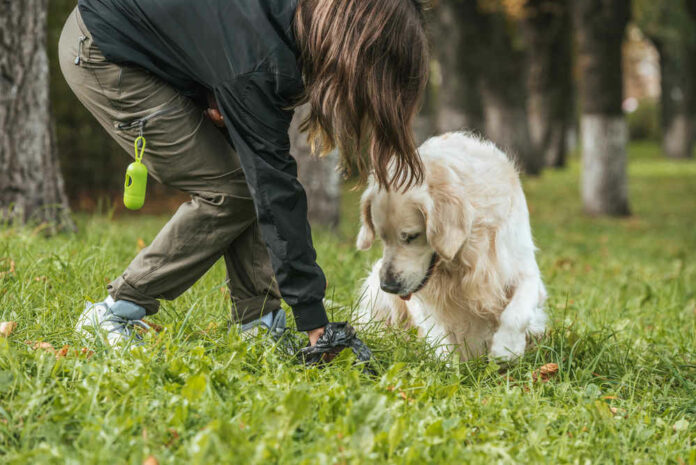Parvo poop smell – Many new dog owners get worried when their dogies have diarrhea because it could be a sign of a serious illness called parvovirus. That is why we are here to know all about the “parvo poop smell.” It might not be a good thing, but it is important to be able to identify it early. This helps us act quickly and differentiate it from other other problems of the puppy, like colitis. Knowing the smell is considered as one of the first hints.
After the vet visit, you can also help your dog recover at home by providing the right diet, probiotics, and vitamin supplements to help their stomach get back to normal.
So, the key here is to be able to spot the signs of parvovirus as early as possible, and it all starts with knowing what parvo poop smells like.
What is the Parvo Poop Smell?
The parvo poop smell is unique because it is kind of metallic, and that is because there is much blood in the feces. As the disease gets worse, the lining of the puppy’s intestines starts to come apart, and that is when you get a rotting smell and sickly-sweet.
Parvovirus really messes up a puppy’s intestines and stomach, and that is why the poop has that weird metallic, bloody, rotting parvo in dogs.
Parvo cases can get serious fast, so you need to act quickly and take your pup to the vet as soon as you notice parvo poop or any other signs. Even if your dog has been vaccinated, they can still get sick from parvo when they’re young.
So, vaccinations are important, but it is important to watch out for parvo poop and other symptoms.
The parvovirus, which spreads easily among dogs, can be transmitted through dog-to-dog contact or by coming into contact with dog poop infection, vomit, contaminated areas, or even people.
It is important to be able to identify parvo in dogs because doing so can help prevent the infected puppy from passing the disease to their littermates. This is done by quickly isolating the sick pup.
Although different species of mammals have their own specific strains of parvovirus, other pets in your home can still be at risk if there is a dog with parvo. For instance, cats cannot catch the exact same parvovirus that affects dogs, but they can potentially get some new mutated forms of it.
Parvo is a tough virus that can survive in various conditions, including cold, heat, dryness, and humidity. Once it gets into an environment, it can remain alive for six months to a year. Even cold weather, like snow, will not completely kill the virus unless it is properly treated with bleach.
How to Identify Parvo Poop?
When you are trying to spot signs of Parvo, one of the first things to watch for is changes in your puppy’s poop. When checking your puppy’s poop, pay attention to three things: its colour, texture, and any covering it might have.
Color of Parvo Poop
Initially, the poop should be a light yellow colour. However, as the disease progresses, it can get darker because of the increasing amount of blood in the intestines. So, you might notice the poop changing from a yellowish-brown to a dark red, and in the later stages, it might even become nearly black.
Consistency of Parvo Poop
At first, Parvo poop may start as a slightly loose stool, and then it gradually turns into something more watery until it becomes almost liquid.
Covering of Parvo Poop
In the early stages of the disease, the stomach sheds its lining, so you might notice a lump of poop mucus. This mucus is actually from the intestines.
What Parvo Does Inside a Puppy
This illness harms the tiny finger-like structures in the intestinal lining, which are responsible for absorbing nutrients. As a result, the puppy cannot properly take in the nutrients it needs.
Parvo can also harm the rapidly dividing cells in the heart, causing a rare condition called Canine Parvovirus-Induced Myocarditis. However, this is not very common. In this form, dogs can suddenly pass away without warning signs like unusual poop. This type of parvo mostly affects young puppies under eight weeks old.
When the intestinal barrier breaks down, it allows bacteria to enter the bloodstream, leading to a serious condition called septicemia that can be deadly for dogs. The diarrhoea also leads to anaemia, which can make the gums pale. They only turn pink again when you put pressure on them.
Parvo Poop Stages: How do you know if a Puppy Has Parvo?
Dogs that have parvo experience sudden vomiting and diarrhea, and the smell can be really strong and stick around even after you have cleaned everything up. As Parvo keeps affecting the dog’s body, the vomiting and diarrhea become more severe and go through different stages, like this:
Incubation Period:
During the incubation period, the poop is loose or runny, but it still looks like regular poop in terms of colour. It can take up to 7 days before any disease’s smptoms to the virus.
The Symptomatic Period:
When the signs of parvo start to appear, the poop becomes even more watery and turns from brownish to blackish diarrhea with some traces of blood. Once the parvo symptoms show up and the diarrhea becomes smelly and bloody, it does not make it survive only for symptoms of 2-3 days after they appear.
Illness:
As the disease goes on, the poop from a dog with parvo becomes even bloodier and more watery. When dogs get sick with parvo, they usually stop eating, so their poop ends up being mostly water with blood in it.
How to recover
Puppies that manage to survive parvo still have diarrhoea, but with time, their poop starts to get thicker and goes back to its usual colour as they recover. You might still see a little blood in the stool, but that gradually goes away as the intestines heal.
What Are the Initial Signs of Parvo in Dogs?
When puppies have a gastrointestinal illness called parvo, it can take more than a week after being exposed to the virus before they start showing any signs of being sick. Sadly, most puppies with parvo die in 72 hours after the first signs appear.
So, it is really important to act quickly and get to the vet as soon as you notice any of these signs in an infected pup to increase their chances of survival.
Unlike some other illnesses, the time between the early signs showing up and the pup getting very sick is quite short. So, even if you spot these symptoms early, it doesn’t guarantee a full recovery because damage may have already been done.
But knowing these parvo symptoms is still important because it means you can seek important help from a vet.
Can Dogs Catch Parvo Poop Smell?
Since parvovirus is spread through feces, dogs can potentially get infected when they stop to sniff another dog’s poop. Moreover, if your puppy sniffs or steps in that area, they could catch it.
That is why it is important to limit your puppy’s exposure to uncontrolled public places.
What is the Smell of Parvo’s Breathe in Dogs?
The sweet, metallic, rotting smell mainly comes from their feces. However, as a dog with parvo becomes more unwell, their breath might start to smell unpleasant, like sourness or even sulfur. This can happen because there might be less saliva in their mouth, allowing harmful bacteria to grow and cause a bad smell.
Early Parvo Symptoms
- Depression and Lethargy: Dogs with parvo feel tired and down.
- No appetite: Parvo makes dogs not want to eat because it upsets their stomach.
- Fever: They might have a high body temperature at first, but it goes down as they start vomiting and having diarrhea.
Some Questions
What does parvo poop smell like?
Parvo poop can have a particularly foul smell, often described as putrid or having a strong, pungent smell.
What causes the smell of parvo poop?
The unpleasant smell is largely due to the viral infection affecting the digestive system.
Can I smell parvo from my dog’s poop?
Yes, you may be able to smell parvo from your dog’s poop. However, it is important to note that a foul-smelling poop does not necessarily mean that your dog has parvo. Other gastrointestinal issues can also cause a bad smell.









![Can Lobsters feel Pain? [Details Inside] Can Lobsters feel Pain](https://www.abestfashion.com/wp-content/uploads/2023/03/image-asset-1-218x150.jpeg)






